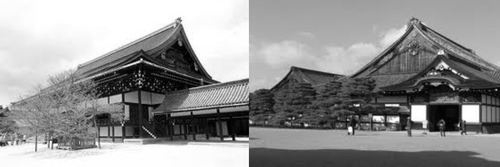Origins of Legitmacy
 What legitimizes the Emperor’s right to rule is of a completely different origin, perhaps even a different cosmic space, from the source of the Shogun’s rights to rule. The Emperor’s legitimacy stems from his direct connection to the Sun Goddess, Amaterasu as her direct descendent. This spiritual link between the heavens and the Emperor is his sole source of legitimacy to power. In the imperial palace of Kyoto Gosho, this link is imprinted in the architecture. When visitors were allowed into the main hall, Shishinden, they would immediately be aware of the unveiled roof, open to the sun and all the other natural elements. This openness towards nature serves as a constant reminder to those who enter of the Imperial family's connection to nature and the heavens. In the Emperor’s private residence hall, Seiryoden, the floors of his room is made of white waxed plaster so the Emperor would be allowed to be in direct contact with the earth when performing private rituals. The connection between the heavens and the imperial family is apparent and not allowed to be forgotten with the white gravel gardens that surrounds the entire palace. The white gravel, a symbol of purity, it the location of the man necessary rituals performed by the Emperor.
What legitimizes the Emperor’s right to rule is of a completely different origin, perhaps even a different cosmic space, from the source of the Shogun’s rights to rule. The Emperor’s legitimacy stems from his direct connection to the Sun Goddess, Amaterasu as her direct descendent. This spiritual link between the heavens and the Emperor is his sole source of legitimacy to power. In the imperial palace of Kyoto Gosho, this link is imprinted in the architecture. When visitors were allowed into the main hall, Shishinden, they would immediately be aware of the unveiled roof, open to the sun and all the other natural elements. This openness towards nature serves as a constant reminder to those who enter of the Imperial family's connection to nature and the heavens. In the Emperor’s private residence hall, Seiryoden, the floors of his room is made of white waxed plaster so the Emperor would be allowed to be in direct contact with the earth when performing private rituals. The connection between the heavens and the imperial family is apparent and not allowed to be forgotten with the white gravel gardens that surrounds the entire palace. The white gravel, a symbol of purity, it the location of the man necessary rituals performed by the Emperor.
The Shogun’s legitimacy is of a more tangible source, the Emperor. Despite the power of the Shogun, he is only legitimate as long as the Emperor acknowledges his position and power. Without the support of the imperial family, the title of Shogun would be non-existent. The Nijo Castle’s very location is a proof of this fact. The Shogun’s main residence and center of power is Edo, today known as Tokyo. Nijo castle however was built in Kyoto as the residence of the Shogun when he was required to meet with the Emperor. The Shogun had to journey to Kyoto because it was where the imperial family resided during the Tokugawa rule. In addition, the Ninomaru palace was built for the sole purpose of receiving Emperor Go-Mizunoo. Although, the Shogun by that time had seized most of the Emperor’s authoritative power, he was unable to usurp the position. To the people of Japan, the Emperor is the undisputed religious leader. For that very reason, the Nijo Castle held no architectural forms that were for religious purpose such as the white gravel of the Kyoto Gosho.
